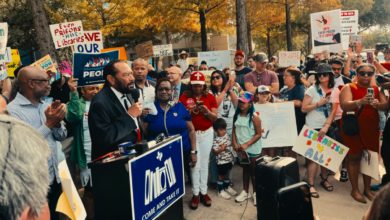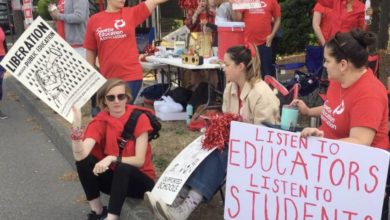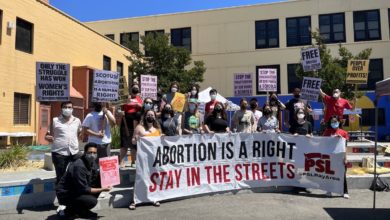“We are faced with the end to public higher education in Colorado.”
Those stark words came from University of Colorado president Elizabeth Hoffman in March 2004 (Chronicle of Higher Education, March 26, 2004). Although she was referring to specific threats facing state education funding in Colorado, her comments are a response to the growing attacks on public education across the United States.
In California, 3,800 teachers and 9,000 other school employees were fired in 2003. In Kansas, half of the school districts have cut staff; some districts have gone to four-day week schedules and 50 schools now charge students for extracurricular activities.1
The public higher education sector—colleges and universities—is particularly important to look at for trends in national government spending. Unlike primary- and secondary-level education, higher education depends heavily on federal government spending. Public universities and colleges depend on federal dollars for one-third of their budget.2
The trend in higher education has been toward decreased federal spending, increased tuition, and increased pressure for privatization. According to “Trends in College Pricing 2003,” tuition and fees at public two- and four-year colleges and universities increased by an average of 14 percent compared to 2002. Adding tuition, room and board, and other expenses, public institutions cost an annual average of $13,833 for an in-state student and $20,879 on average for an out-of-state student.3
Shifting financial burden
These figures are part of a systemic trend that started in the late 1970s toward shifting the burden of funding education from the state and federal governments to students and their families. This burden fell more heavily on working class families—those more likely to use public education—than on wealthier families.
In the 1970s, need-based grants made up 61 percent of all federal student aid. Today, they make up only 22 percent. Today, families with yearly income of $25,000 and less can be asked to pay as much as 71 percent of those earnings to send someone to college, while families with incomes over $99,000 pay only 5 to 6 percent. Non-federal loans through banks and private lenders amounted to $7.5 billion in 2003, an increase of 41 percent from 2002 alone.4
With the trend toward loan-financed education, the banking industry has profited heavily. Some 64 percent of students leave college in debt. The average debt is almost $17,000. Mean while, fi nan cial giants like SLM Corp. (known as Sallie Mae) earned $792 million in 2002.5
On top of these loans, 25 percent of students depend on credit cards to finance higher education—usually paying much higher interest rates.6
Education suits economic needs
The increased under-funding, larger role of private lending and moves to privatization of the education system are not simply the result of poor planning or a massive budget crisis. These trends need to be viewed in the context of the basic function that public education fulfills in U.S. capitalist society—that is to train students to be workers. Because of this, the character of the educational system in the U.S. has evolved (or de-evolved) according to shifts in the economy and the changing needs of the ruling class.
The first system of public education in the U.S. was a network of common schools that had as its primary purpose “the socialization of immigrants into American life and culture.” Between 1830 and 1840, almost 500,000 immigrants came to the U.S. By the late 1800s 500,000 people immigrated to the U.S. every year. The common schools served to prepare these new workers to enter the workforce and assimilate into the dominant culture—U.S. ruling class culture.7
The predecessor to the modern-day school, the factory school, was a result of the shift that the U.S. economy made from a primarily agrarian economy to an industrial one in the early 1900s. The new type of school, which was compulsory, was funded partly by prop erty taxes and partly by industrial “philanthropists” like the Rock e fellers. The aim of these schools was to in cul cate workers ar riving from farms and other rural areas into the factory environment.8,9,10
Serious government investment in public higher education didn’t begin until after World War II. It coincided with the emergence of the United States as a world superpower and the growing need for more skilled workers. This effort was accelerated by the economic and technological competition with the socialist camp, especially after the Soviet Union launched Sputnik—the first orbiting space satellite.
Today’s trend toward de-funding and privatizing public education reflects a shift in the U.S. economy. Beginning in the late 1970s, the U.S. economy underwent a high-tech transformation, a retooling that featured computerization, robotics, telecommunications, and mini a turization. Corresponding to this transformation has been a major shift from relatively skilled, higher-paying manufacturing jobs toward low-skill, low-paying service sector jobs. Huge numbers of workers lost their jobs outright in this shift—15 million between 1981 and 1996.
The increase in lower-skill jobs means a lesser need on the part of the employers for the skills that college and university education provides. The changed needs of the ruling class can be seen, for example, in the comparison between education funding and prison funding. Between 1980 and 2000, prison spending by state governments in creased 189 percent while education spending increased only 32 percent.11
The epitome of the role of education in the low-skill service economy might be seen in the absurd but growing “McTeacher’s Night” program, held in 16 states during March 2004. Teachers and principals were encouraged to flip burgers for an evening to earn a portion of the night’s profits for their school. The publicity stunt earned each of 1,000 schools less than $700.12
While the corporate ruling class has its own aims for public education, the working class movement has always fought for a separate vision: education as a tool for liberation. This democratic vision of education has inspired social struggles for increased access to the knowledge produced by society.
May 2004 marked the 50th anniversary of the historic Brown v. Board of Education Supreme Court decision to desegregate public schools, a response to the growing civil rights movement. Despite that ruling, the education system remains largely segregated and unequal. The July-August 2004 issue of The Atlantic Monthly reported that in Los Angeles, “The worst schools—the seven exhibiting serious problems with teachers, curricula, and facilities—collectively educate a population that is 94 percent Black and Hispanic,” while not one school that is predominately white faces these problems. The worst injustices of institutionalized racism in U.S. capitalist society are replicated in the education system, and workers from oppressed communities face far greater obstacles to receive a decent education.
The growing movements for access to education and multicultural curricula are important struggles in the fight to extend educational opportunities to all poor and working people. In order for education to truly serve the people, it must be taken out of the hands of those whose only interests are perpetuating the profit-driven capitalist system.
Notes
1. Goodman, David, “Class Dismissed.” Mother Jones, May/June 2004.
2. Reed, Adolph and Sharon Szymanski, “Free Higher Education.” Academe, July-August 2004.
3. Baum, Sandy and Kathleen Payea. “Trends in College Pricing 2003.” http://www.thecollegeboard.com
4. Reed, Adolph and Sharon Szymanski, “Free Higher Education.” Academe, July-August 2004.
5. “Big Money on Campus,” www.USNews.com, Oct. 22, 2003.
6. Reed, Adolph and Sharon Szymanski, “Free Higher Education.” Academe, July-August 2004.
7. Perko, F. Michael. “Education, socialization, and development of national identity.” Shofar, Winter 2003 v.2 i2, p.101.
8. Moore, Deborah. “Education Through the Ages.”CASchool Planning and Management, Nov. 2000 v39 i11 p10.
9. Goldin, Claudia and Lawrence F. Katz. “Human capital and social capital: the rise of secondary schooling in America 1910-1940.” The Journal of Interdisciplinary History, Spring 1999 v29 i4 p683.
10. Tyack, David. The One Best System: A History of American Urban Education. Harvard University Press Dec. 1, 1974.
11. “Debt to Society,” MotherJones.com, Special report. www.motherjones.com/news/special_reports/prisons/atlas.html
12. Goodman, David. “Class Dismissed.” Mother Jones, May/June 2004
15 5 minutes read






